An Analysis of the Canadian Judiciary's Response to Racial Inequality
VerifiedAdded on 2023/06/04
|7
|1218
|342
Essay
AI Summary
This essay examines the issue of racial inequality in Canada, focusing on the response of the Canadian judiciary. It analyzes various aspects of racial disparities, including income, education, and treatment within the legal system. The essay explores specific cases and legal actions, such as the Anti-Racism Act 2017 and the handling of discrimination complaints. It highlights how the judiciary attempts to address issues like harassment, unequal pay, and educational disparities, offering an overview of the laws and policies implemented to combat racial inequality and their impact on society. The essay discusses the role of the judiciary in promoting social justice and equality, and how legal decisions have shaped the landscape of racial relations in Canada.
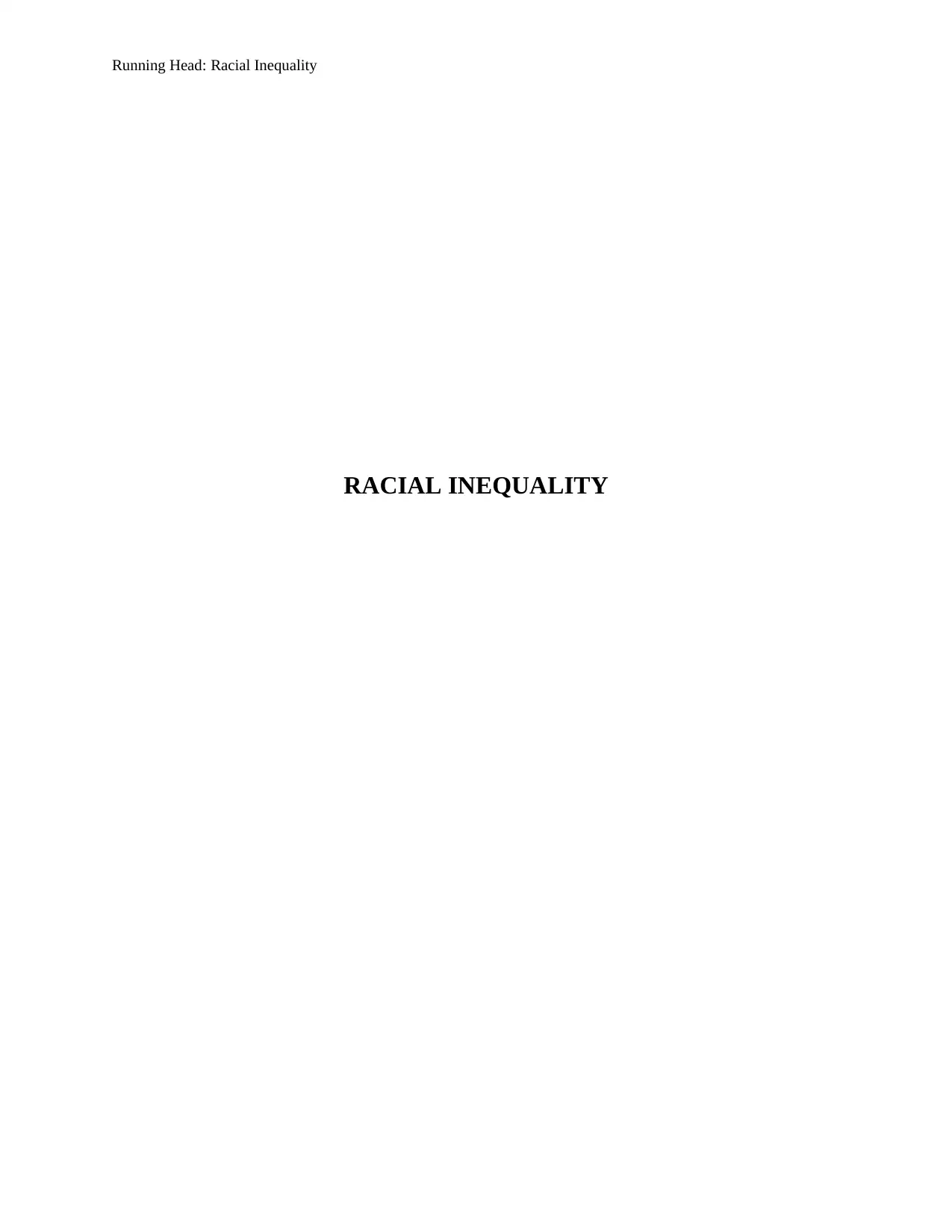
Running Head: Racial Inequality
RACIAL INEQUALITY
RACIAL INEQUALITY
Paraphrase This Document
Need a fresh take? Get an instant paraphrase of this document with our AI Paraphraser
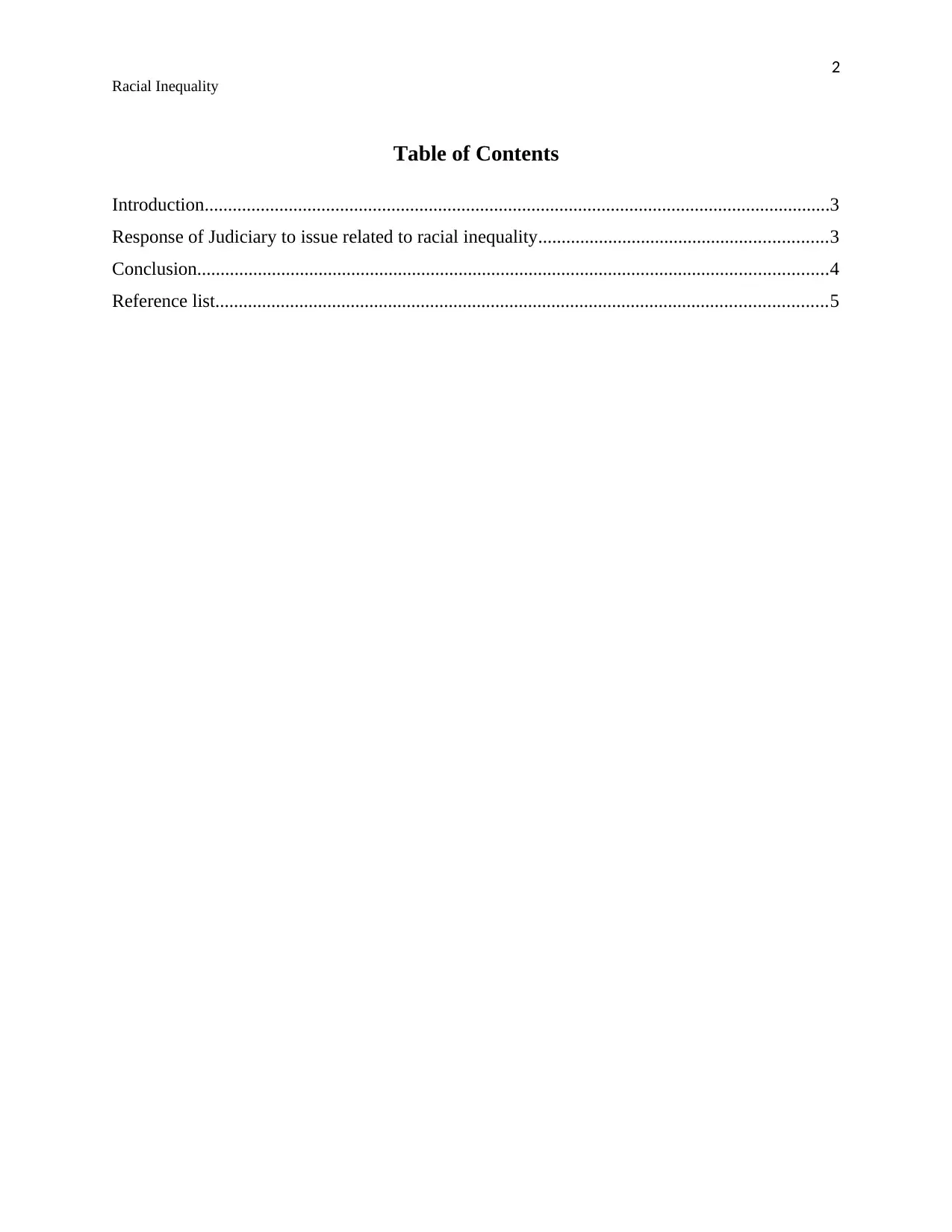
2
Racial Inequality
Table of Contents
Introduction......................................................................................................................................3
Response of Judiciary to issue related to racial inequality..............................................................3
Conclusion.......................................................................................................................................4
Reference list...................................................................................................................................5
Racial Inequality
Table of Contents
Introduction......................................................................................................................................3
Response of Judiciary to issue related to racial inequality..............................................................3
Conclusion.......................................................................................................................................4
Reference list...................................................................................................................................5

3
Racial Inequality
Introduction
It is quite unfortunate in the twenty first century that people of Canada face issue related
to racial inequality and it leaves negative impact on society. However, the thesis statement of
study is to analyse the judiciary response from Canadian Regime related to the issue of racial
inequality. The racial inequality refers to the social advantage and the disparities that directly
affect the different races, where there are manifestations with proper distribution of wealth,
power and the opportunities in life. The results are of the historic oppression, with inequality of
inheritance and the prejudice which is found to be against the set of minority groups. The social
science includes the wider range of the racial disparities in wealth, rate of poverty and the
housing patterns that leads to handling the incarceration rates.
Response of Judiciary to issue related to racial inequality
As per the report of The Star, it is seen that around 32% Canadian people believe that
racism has become a significant problem in the present era. It is observed that Racialized
Canadian people earn around $30385 in a year, where as other people earn around $37332
(thestar.com, 2012). In this context, Judiciary has tried to analyse the above-mentioned issue and
develop effective law in order to solve the above mention situation in an appropriate manner.
For example, in case of E.T. v Dress Code Express Inc., 2017 HRTO 595, it is monitored
that the case is about sexual harassment faced by applicant. Tribunal has found out that applicant
expressed that she never engages with black people for sexual purpose and as a result, she has
faced racial and sexual harassment. It is the violation of Refuge and Immigration Protection Act.
In this case, Judiciary or Tribunal has order to provide $15000compensation for this harassment.
In addition to this, Judiciary has tried to develop effective law for reducing the above-mentioned
issue (hrlsc.on.ca, 2017). In context of the racial inequality, judicial authority of Canada has tried
to reduce harassment by developing policy related to harassment. They also focus on the
discrimination in payment in workplace for decreasing issuer related to it (Malcolmson, Myers,
Baier & Bateman, 2016).
Racial Inequality
Introduction
It is quite unfortunate in the twenty first century that people of Canada face issue related
to racial inequality and it leaves negative impact on society. However, the thesis statement of
study is to analyse the judiciary response from Canadian Regime related to the issue of racial
inequality. The racial inequality refers to the social advantage and the disparities that directly
affect the different races, where there are manifestations with proper distribution of wealth,
power and the opportunities in life. The results are of the historic oppression, with inequality of
inheritance and the prejudice which is found to be against the set of minority groups. The social
science includes the wider range of the racial disparities in wealth, rate of poverty and the
housing patterns that leads to handling the incarceration rates.
Response of Judiciary to issue related to racial inequality
As per the report of The Star, it is seen that around 32% Canadian people believe that
racism has become a significant problem in the present era. It is observed that Racialized
Canadian people earn around $30385 in a year, where as other people earn around $37332
(thestar.com, 2012). In this context, Judiciary has tried to analyse the above-mentioned issue and
develop effective law in order to solve the above mention situation in an appropriate manner.
For example, in case of E.T. v Dress Code Express Inc., 2017 HRTO 595, it is monitored
that the case is about sexual harassment faced by applicant. Tribunal has found out that applicant
expressed that she never engages with black people for sexual purpose and as a result, she has
faced racial and sexual harassment. It is the violation of Refuge and Immigration Protection Act.
In this case, Judiciary or Tribunal has order to provide $15000compensation for this harassment.
In addition to this, Judiciary has tried to develop effective law for reducing the above-mentioned
issue (hrlsc.on.ca, 2017). In context of the racial inequality, judicial authority of Canada has tried
to reduce harassment by developing policy related to harassment. They also focus on the
discrimination in payment in workplace for decreasing issuer related to it (Malcolmson, Myers,
Baier & Bateman, 2016).
⊘ This is a preview!⊘
Do you want full access?
Subscribe today to unlock all pages.

Trusted by 1+ million students worldwide
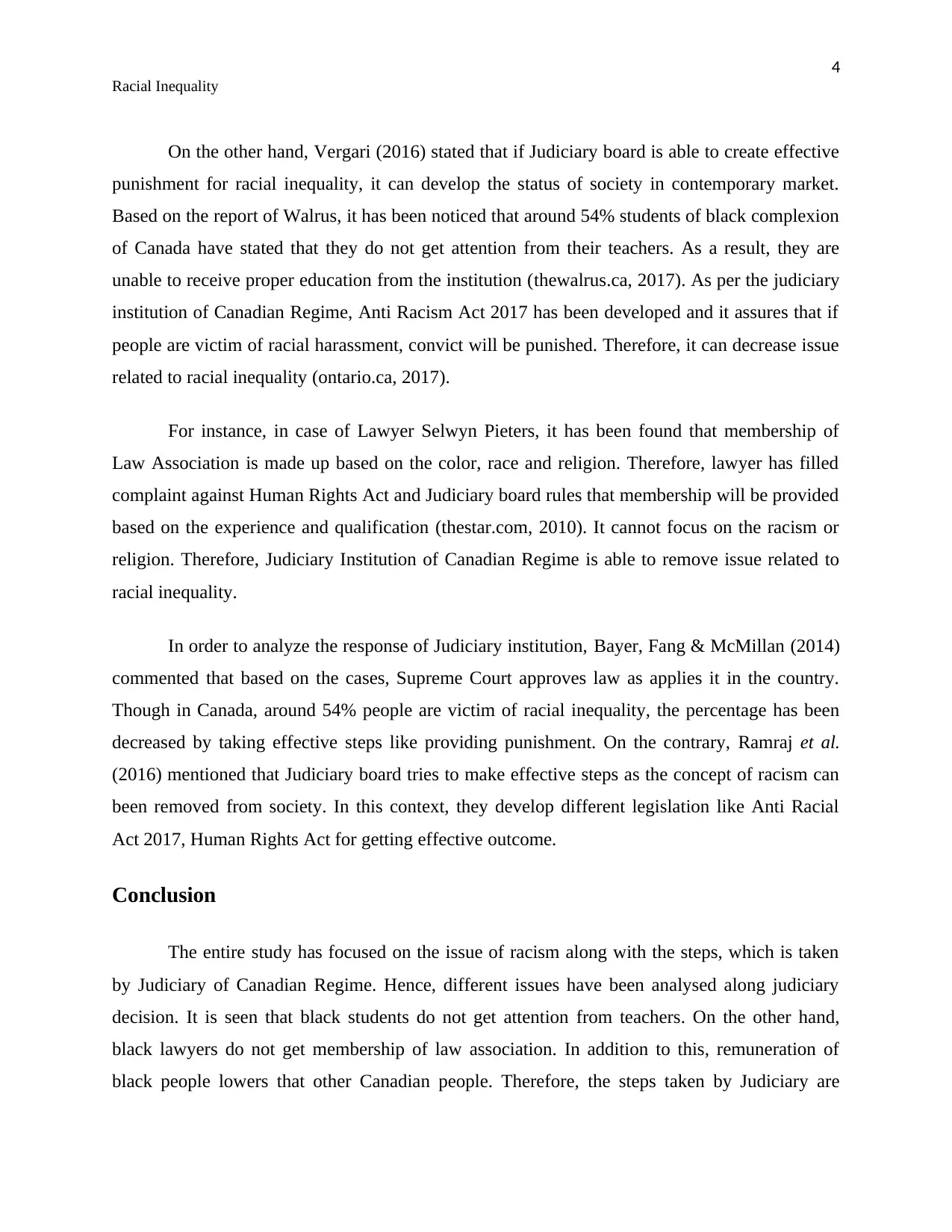
4
Racial Inequality
On the other hand, Vergari (2016) stated that if Judiciary board is able to create effective
punishment for racial inequality, it can develop the status of society in contemporary market.
Based on the report of Walrus, it has been noticed that around 54% students of black complexion
of Canada have stated that they do not get attention from their teachers. As a result, they are
unable to receive proper education from the institution (thewalrus.ca, 2017). As per the judiciary
institution of Canadian Regime, Anti Racism Act 2017 has been developed and it assures that if
people are victim of racial harassment, convict will be punished. Therefore, it can decrease issue
related to racial inequality (ontario.ca, 2017).
For instance, in case of Lawyer Selwyn Pieters, it has been found that membership of
Law Association is made up based on the color, race and religion. Therefore, lawyer has filled
complaint against Human Rights Act and Judiciary board rules that membership will be provided
based on the experience and qualification (thestar.com, 2010). It cannot focus on the racism or
religion. Therefore, Judiciary Institution of Canadian Regime is able to remove issue related to
racial inequality.
In order to analyze the response of Judiciary institution, Bayer, Fang & McMillan (2014)
commented that based on the cases, Supreme Court approves law as applies it in the country.
Though in Canada, around 54% people are victim of racial inequality, the percentage has been
decreased by taking effective steps like providing punishment. On the contrary, Ramraj et al.
(2016) mentioned that Judiciary board tries to make effective steps as the concept of racism can
been removed from society. In this context, they develop different legislation like Anti Racial
Act 2017, Human Rights Act for getting effective outcome.
Conclusion
The entire study has focused on the issue of racism along with the steps, which is taken
by Judiciary of Canadian Regime. Hence, different issues have been analysed along judiciary
decision. It is seen that black students do not get attention from teachers. On the other hand,
black lawyers do not get membership of law association. In addition to this, remuneration of
black people lowers that other Canadian people. Therefore, the steps taken by Judiciary are
Racial Inequality
On the other hand, Vergari (2016) stated that if Judiciary board is able to create effective
punishment for racial inequality, it can develop the status of society in contemporary market.
Based on the report of Walrus, it has been noticed that around 54% students of black complexion
of Canada have stated that they do not get attention from their teachers. As a result, they are
unable to receive proper education from the institution (thewalrus.ca, 2017). As per the judiciary
institution of Canadian Regime, Anti Racism Act 2017 has been developed and it assures that if
people are victim of racial harassment, convict will be punished. Therefore, it can decrease issue
related to racial inequality (ontario.ca, 2017).
For instance, in case of Lawyer Selwyn Pieters, it has been found that membership of
Law Association is made up based on the color, race and religion. Therefore, lawyer has filled
complaint against Human Rights Act and Judiciary board rules that membership will be provided
based on the experience and qualification (thestar.com, 2010). It cannot focus on the racism or
religion. Therefore, Judiciary Institution of Canadian Regime is able to remove issue related to
racial inequality.
In order to analyze the response of Judiciary institution, Bayer, Fang & McMillan (2014)
commented that based on the cases, Supreme Court approves law as applies it in the country.
Though in Canada, around 54% people are victim of racial inequality, the percentage has been
decreased by taking effective steps like providing punishment. On the contrary, Ramraj et al.
(2016) mentioned that Judiciary board tries to make effective steps as the concept of racism can
been removed from society. In this context, they develop different legislation like Anti Racial
Act 2017, Human Rights Act for getting effective outcome.
Conclusion
The entire study has focused on the issue of racism along with the steps, which is taken
by Judiciary of Canadian Regime. Hence, different issues have been analysed along judiciary
decision. It is seen that black students do not get attention from teachers. On the other hand,
black lawyers do not get membership of law association. In addition to this, remuneration of
black people lowers that other Canadian people. Therefore, the steps taken by Judiciary are
Paraphrase This Document
Need a fresh take? Get an instant paraphrase of this document with our AI Paraphraser

5
Racial Inequality
described thoroughly throughout the study. Thus, thesis statement of study has been met in
appropriate manner.
Racial Inequality
described thoroughly throughout the study. Thus, thesis statement of study has been met in
appropriate manner.
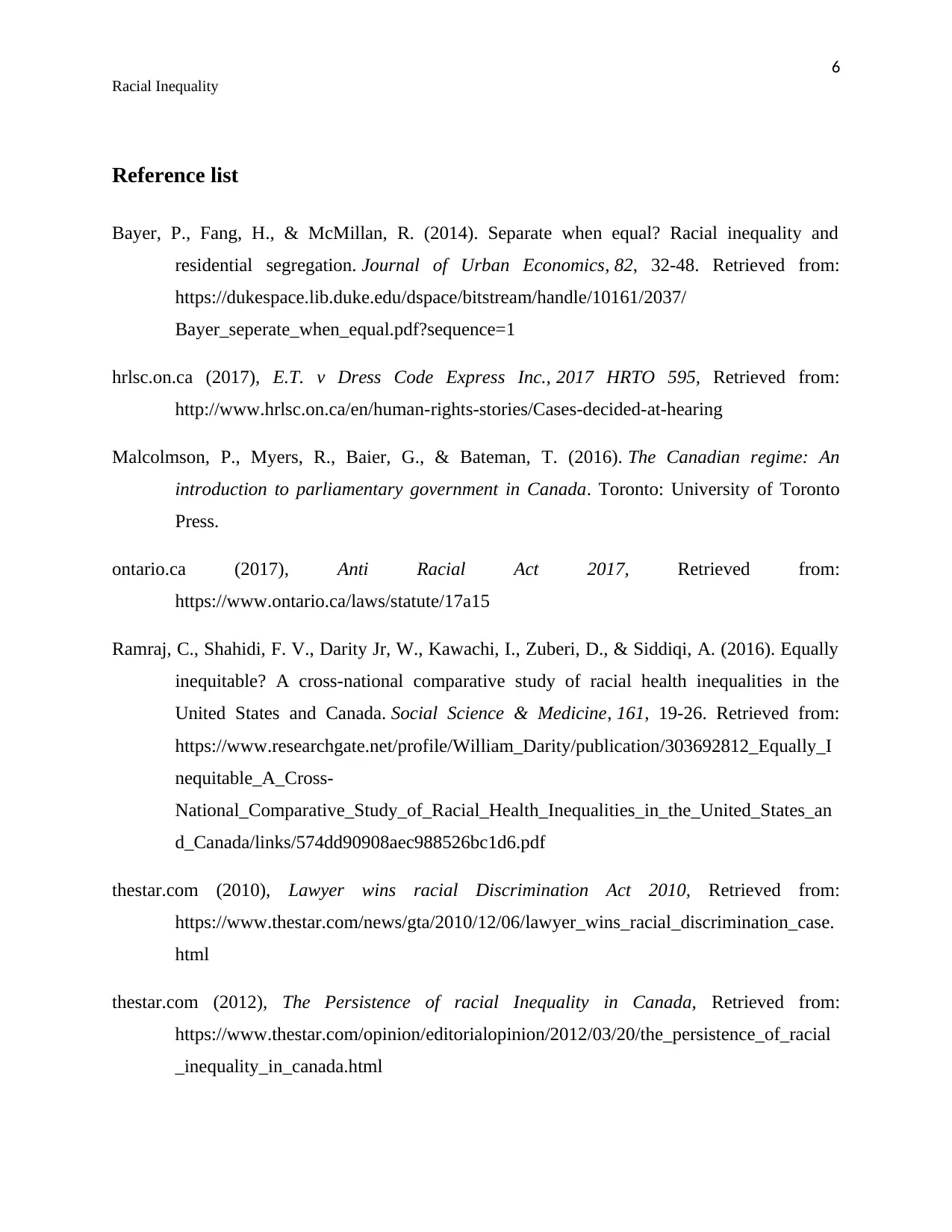
6
Racial Inequality
Reference list
Bayer, P., Fang, H., & McMillan, R. (2014). Separate when equal? Racial inequality and
residential segregation. Journal of Urban Economics, 82, 32-48. Retrieved from:
https://dukespace.lib.duke.edu/dspace/bitstream/handle/10161/2037/
Bayer_seperate_when_equal.pdf?sequence=1
hrlsc.on.ca (2017), E.T. v Dress Code Express Inc., 2017 HRTO 595, Retrieved from:
http://www.hrlsc.on.ca/en/human-rights-stories/Cases-decided-at-hearing
Malcolmson, P., Myers, R., Baier, G., & Bateman, T. (2016). The Canadian regime: An
introduction to parliamentary government in Canada. Toronto: University of Toronto
Press.
ontario.ca (2017), Anti Racial Act 2017, Retrieved from:
https://www.ontario.ca/laws/statute/17a15
Ramraj, C., Shahidi, F. V., Darity Jr, W., Kawachi, I., Zuberi, D., & Siddiqi, A. (2016). Equally
inequitable? A cross-national comparative study of racial health inequalities in the
United States and Canada. Social Science & Medicine, 161, 19-26. Retrieved from:
https://www.researchgate.net/profile/William_Darity/publication/303692812_Equally_I
nequitable_A_Cross-
National_Comparative_Study_of_Racial_Health_Inequalities_in_the_United_States_an
d_Canada/links/574dd90908aec988526bc1d6.pdf
thestar.com (2010), Lawyer wins racial Discrimination Act 2010, Retrieved from:
https://www.thestar.com/news/gta/2010/12/06/lawyer_wins_racial_discrimination_case.
html
thestar.com (2012), The Persistence of racial Inequality in Canada, Retrieved from:
https://www.thestar.com/opinion/editorialopinion/2012/03/20/the_persistence_of_racial
_inequality_in_canada.html
Racial Inequality
Reference list
Bayer, P., Fang, H., & McMillan, R. (2014). Separate when equal? Racial inequality and
residential segregation. Journal of Urban Economics, 82, 32-48. Retrieved from:
https://dukespace.lib.duke.edu/dspace/bitstream/handle/10161/2037/
Bayer_seperate_when_equal.pdf?sequence=1
hrlsc.on.ca (2017), E.T. v Dress Code Express Inc., 2017 HRTO 595, Retrieved from:
http://www.hrlsc.on.ca/en/human-rights-stories/Cases-decided-at-hearing
Malcolmson, P., Myers, R., Baier, G., & Bateman, T. (2016). The Canadian regime: An
introduction to parliamentary government in Canada. Toronto: University of Toronto
Press.
ontario.ca (2017), Anti Racial Act 2017, Retrieved from:
https://www.ontario.ca/laws/statute/17a15
Ramraj, C., Shahidi, F. V., Darity Jr, W., Kawachi, I., Zuberi, D., & Siddiqi, A. (2016). Equally
inequitable? A cross-national comparative study of racial health inequalities in the
United States and Canada. Social Science & Medicine, 161, 19-26. Retrieved from:
https://www.researchgate.net/profile/William_Darity/publication/303692812_Equally_I
nequitable_A_Cross-
National_Comparative_Study_of_Racial_Health_Inequalities_in_the_United_States_an
d_Canada/links/574dd90908aec988526bc1d6.pdf
thestar.com (2010), Lawyer wins racial Discrimination Act 2010, Retrieved from:
https://www.thestar.com/news/gta/2010/12/06/lawyer_wins_racial_discrimination_case.
html
thestar.com (2012), The Persistence of racial Inequality in Canada, Retrieved from:
https://www.thestar.com/opinion/editorialopinion/2012/03/20/the_persistence_of_racial
_inequality_in_canada.html
⊘ This is a preview!⊘
Do you want full access?
Subscribe today to unlock all pages.

Trusted by 1+ million students worldwide
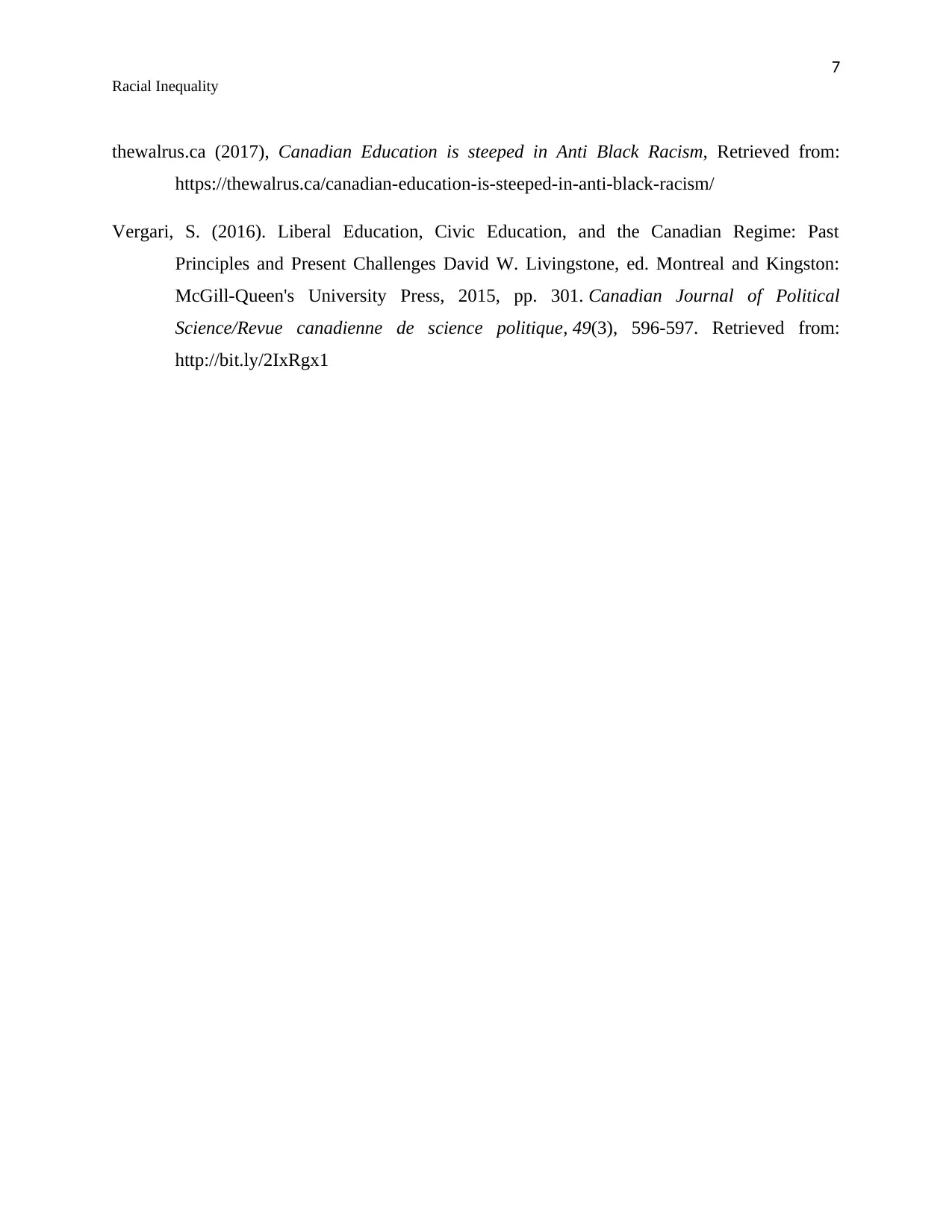
7
Racial Inequality
thewalrus.ca (2017), Canadian Education is steeped in Anti Black Racism, Retrieved from:
https://thewalrus.ca/canadian-education-is-steeped-in-anti-black-racism/
Vergari, S. (2016). Liberal Education, Civic Education, and the Canadian Regime: Past
Principles and Present Challenges David W. Livingstone, ed. Montreal and Kingston:
McGill-Queen's University Press, 2015, pp. 301. Canadian Journal of Political
Science/Revue canadienne de science politique, 49(3), 596-597. Retrieved from:
http://bit.ly/2IxRgx1
Racial Inequality
thewalrus.ca (2017), Canadian Education is steeped in Anti Black Racism, Retrieved from:
https://thewalrus.ca/canadian-education-is-steeped-in-anti-black-racism/
Vergari, S. (2016). Liberal Education, Civic Education, and the Canadian Regime: Past
Principles and Present Challenges David W. Livingstone, ed. Montreal and Kingston:
McGill-Queen's University Press, 2015, pp. 301. Canadian Journal of Political
Science/Revue canadienne de science politique, 49(3), 596-597. Retrieved from:
http://bit.ly/2IxRgx1
1 out of 7
Related Documents
Your All-in-One AI-Powered Toolkit for Academic Success.
+13062052269
info@desklib.com
Available 24*7 on WhatsApp / Email
![[object Object]](/_next/static/media/star-bottom.7253800d.svg)
Unlock your academic potential
Copyright © 2020–2025 A2Z Services. All Rights Reserved. Developed and managed by ZUCOL.




